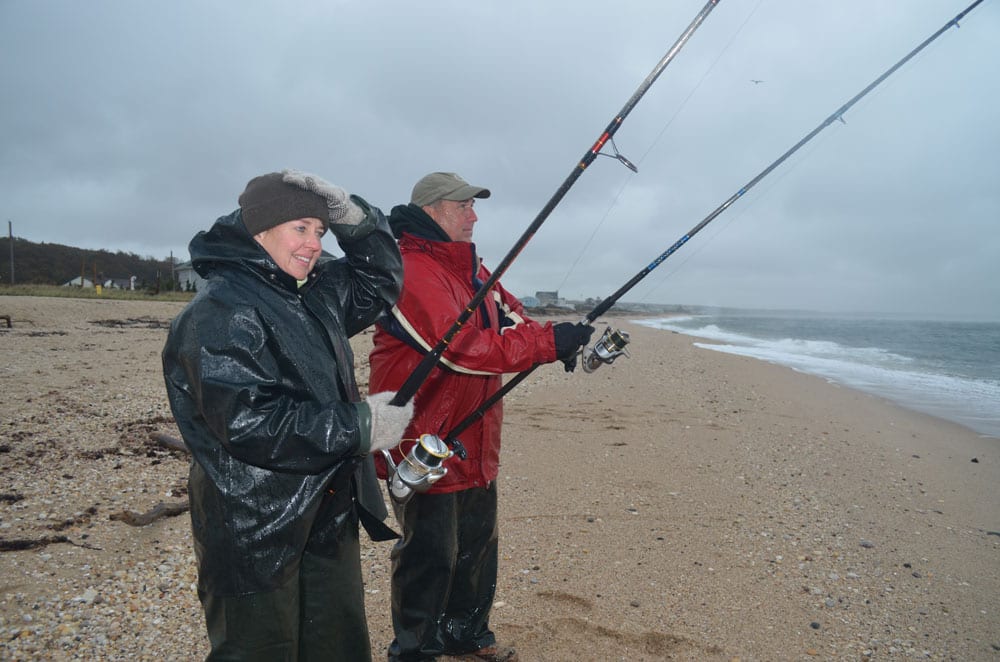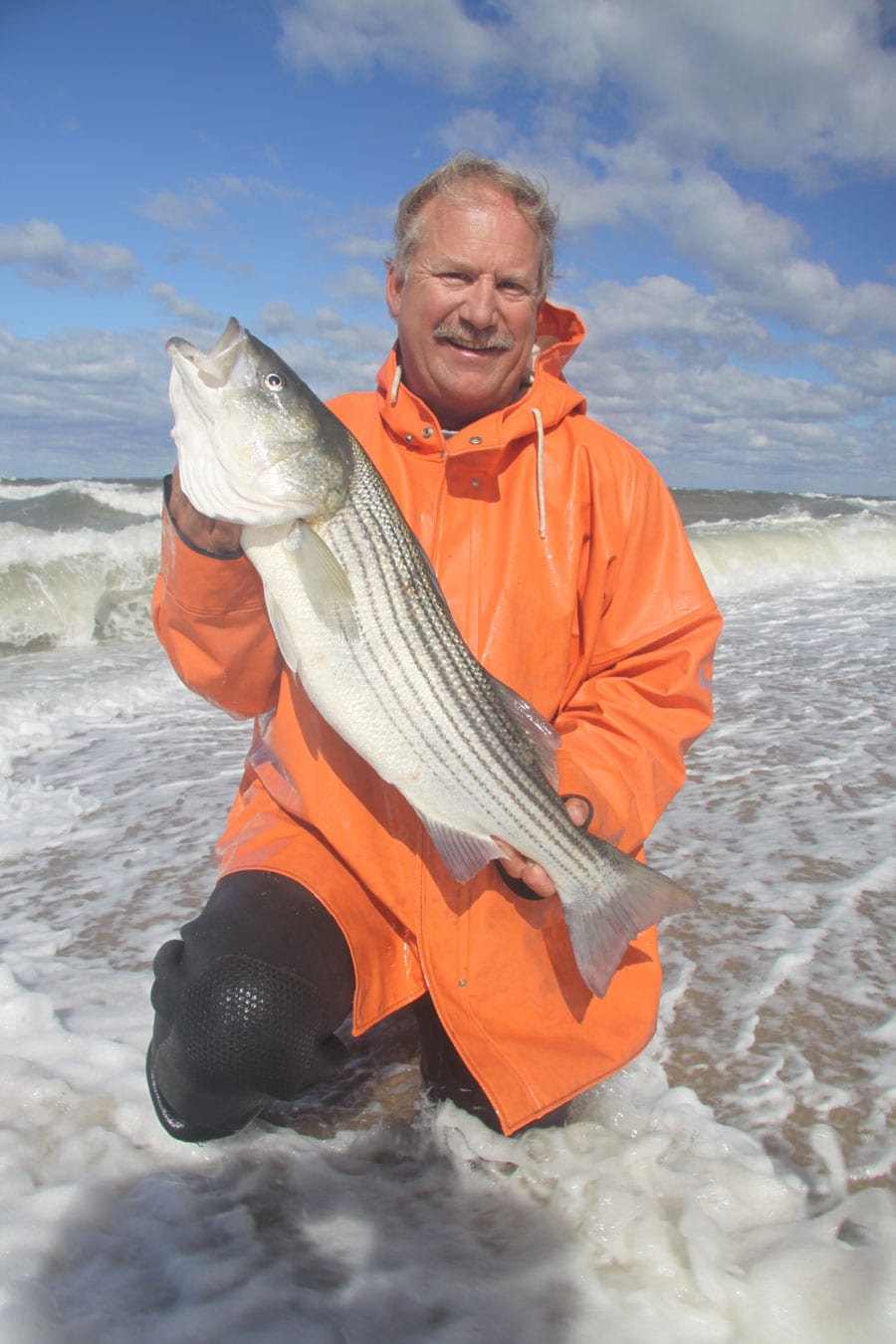
By Tom Schlichter
A young angler smiled, inspected his hook for weeds and made another cast into the crisp, clear waters of the eastern Long Island Sound.
“It’s a beautiful November day,” he said while standing barefoot, pant legs rolled up above his knees. “I’m squeezing in as much fishing I can before everything heads south for the winter,” he continued. I’m not giving up until it starts to snow.”
You’ve got to love that attitude, for November does signal the beginning of the end for Long Island surf fishing. Still, there are a few good days, even weeks ahead. Some will undoubtedly take place in the North Fork waters that angler was fishing, but they are just as likely this time of year to occur along any South Shore beach or toward Long Island’s West End. Come late fall, you see, any stretch of open beach here holds the potential to produce that one last ferocious run of fish anglers crave – the rush they call “The Blitz.”
NOW’S THE TIME
While those aboard boats large enough to safely reach deep water can continue targeting bottom dwelling favorites like blackfish, sea bass and cod into December (blackfish season ends on December 14, sea bass season ends December 31, cod are open year-round), surfcasters are out of luck once a prolonged cold snap or two sends the last remaining beachside predators racing south toward warner water. Fortunately, striped bass and bluefish, the primary local targets, tend to be migration laggards. That means if you haven’t had your fill of them just yet there’s still time if you act fast. It may be last call in the suds but you might just end up having your best trip of the year.
In a mild fall, the blitz might last from late October right through Thanksgiving. If it develops – some years it’s more a trickle than a flood – it’s the kind of action you don’t want to miss. It starts with a splash of sand eels or other baitfish moving tight along the beach. Add a little wind to put the baitfish at a disadvantage in a roiled surf and predator species get riled. At the height of the run they’ll tear into baitfish schools with amazing ferocity. Some baitfish, in fact, may even choose to swim up onto the beach rather than face the wrath of blitzing stripers and chomping blues.

“Late-season blitzes can be pretty amazing,” says surf fishing guide Mark Malvenovsky. A professional fishing guide (www.ny-fishingguide.com) who specializes in putting surfcasters on the action, he notes that water temperatures have remained high through this mild fall season, meaning there’s a good chance the bass and blues will hang around right through Thanksgiving.
“Of course, cautions Malvenovsky,” all bets are off if the baitfish don’t flood the beach, but right now there is still plenty of bunker and we are hoping that sand eels or herring will show up soon.
BEGINNER TIPS
If you’d like to join in on the fun, surf fishing guide Bill Wetzel (www.surfratsball.com) advises anglers to find a couple good spots close to home and work those waters consistently rather than chasing reports of action up and down the coast.
“Pretty much any traditional late fall hot spot will get a shot of fish this time of year, so you are better off getting to know a few spots intimately than trying to figure out a new spot each day.”

Wetzel also advises those new to the surf game to buy the best gear they can afford.
“Once you decide you like the sport, consider it an investment. We live on an island surrounded by surf that holds some really big fish – large blues can top 20 pounds and stripers sometimes top 50 pounds – so you want gear that is of good quality and strong enough to stand up to a trophy. You’ll want an 11-foot surf rod for fishing along the ocean beaches. A nine-foot rod is about right for the North Shore. I use 30- to 40-pound test lines for casting lures and 40- to 50-pound test lines when dunking bait.
Malvenosky, meanwhile, notes that November surf fishing can have a different feel and appearance compared to spring, summer and early fall.
“Once the water begins to get colder, you’ll see less surface action. While fish feeding on top beg for a cast, a lot of times at this point the predators swim by without any birds diving around them or making the slightest dimple on the surface. That means you have to actually make casts to check to each area, so don’t pass up the good spots just because all looks quiet on the surface.”
BUNKER, TINS AND POPPERS
As for bait and lures, keep it simple.
Diamond jigs and poppers are all you really need if starting out. They both cast well into a stiff wind and are virtually indestructible, which is important since bluefish have big teeth. White or blue are the primary popper colors. If you want to fish bait, cut bunker or skimmer clams work best.
The angler I had been watching was taking no chances when I left him on the North Fork beach, waiting for the next big blue or bass to come along and make his day. He hedged his bets by fishing cut bunker on the bottom with one rod in a sand spike while keeping his second stick rigged with a popping plug in case any surface action erupted. Near his cooler laid a 10-pound bluefish that had fallen for the bait.
“I really hope the blitzes come, he mused while sending out another cast. As long as the fish keep biting, I’ll be out here having fun. Every day, that is, except Thanksgiving. That one’s for spending time at home with family no matter how much the fish are blitzing.”
By Tom Schlichter









